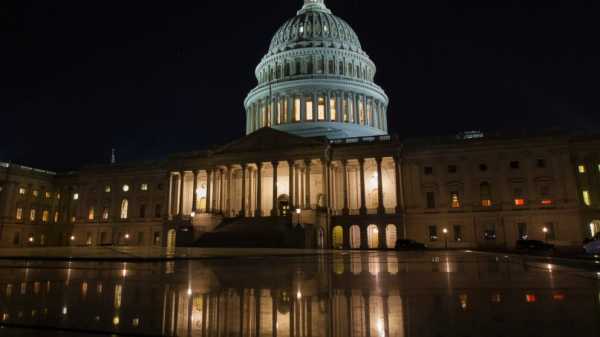
1:50Crowds rally in the rotunda just beyond the Texas House Chamber as legislators deliberate over a revised congressional blueprint during an extraordinary session at the Capitol in Austin on Aug. 20, 2025. Eric Gay/AP
With Texas Republicans poised to enact fresh district boundaries at President Donald Trump’s urging—and Democrats preparing a countermove in California—additional states are considering comparable action.
GOP lawmakers in Indiana, Missouri, and Florida have publicly weighed revamping maps ahead of the 2026 midterms, while Democratic chief executives in Illinois, New York, and Maryland have likewise signaled openness to the same.
Indiana, which currently hosts two Democrat-occupied districts, looks furthest along after Vice President JD Vance conferred with Gov. Mike Braun and legislative leaders on the issue.

A protester delivers remarks on the floor of the Texas Capitol rotunda in Austin on Aug. 20, 2025. Sergio Flores/Reuters
ABC News has surveyed procedures nationwide and spotlighted the states most apt to tackle redistricting. Every state sets its own regulations, and statutes spell out how to execute changes.
Both parties engage in gerrymandering—configuring district lines for partisan advantage. Several states maintain independent or bipartisan panels, created by statute, charged with producing maps.
Bottom line: nationwide, Republicans face broader possibilities to gerrymander House seats than Democrats. In most Democratic-controlled capitols, legal or constitutional guardrails—winning independent commissions in prior cycles and earlier court rulings—curtail the ability to reopen maps mid-decade.
Current House composition: 219 Republicans, 212 Democrats, 4 vacant seats (3 formerly held by Democrats, 1 by the GOP).
Once all vacancies are filled, Republicans would hold a 220-215 majority. To reclaim the House in 2026 under existing lines, Democrats would need a net gain of three seats.
Texas: GOP poised to adopt new map
Current breakdown: 25 Republicans, 13 Democrats.
Projected breakdown after redistricting: 30 Republicans, 8 Democrats, a net gain of +5 for the GOP.
Republican mapmakers propose turning five Democratic districts red by folding blue strongholds in Houston, Austin, and Dallas–Fort Worth into newly crafted Republican seats, while shifting two currently Democratic Rio Grande Valley districts into more competitive territory.
The plan is not expected to erode existing Republican districts and leans on continued Hispanic support for the GOP in 2024 carrying forward into the next cycle.
After an attempted quorum-bust by Democrats stalled the House for two weeks, the legislature still pushed forward; the state Senate could transmit the bill to Gov. Greg Abbott for signature as early as Thursday. If adopted, legal challenges from Democrats are anticipated.

Protesters assemble outside the House Chamber in the rotunda of the Texas Capitol as lawmakers debate a redrawn U.S. congressional map during a special session in Austin on Aug. 20, 2025. Eric Gay/AP
California: Dems pledge to ‘counter punch’
Current composition: 43 Democrats, 9 Republicans.
Projected composition after redistricting or special election: 48 Democrats, 4 Republicans, a net +5 for Democrats.
The California Senate and Assembly are considering Governor Gavin Newsom’s legislative package this week that could trigger a fall ballot measure swapping out the existing House map for the rest of the decade—superseding the commission’s work in favor of a Democratic-friendly plan that would carve out five additional seats.
The revised boundaries would bolster five Democratic districts by folding in reliably blue precincts, while recrafting five GOP districts into easier Democratic targets.
Because the commission is embedded in the state constitution, voter approval is necessary, teeing up a costly and contentious ballot fight set to dominate television and radio ads. The hurdle is steep: the commission was adopted by wide margins before, and depending on polling, independents still favor nonpartisan line-drawing. Former GOP Governor Arnold Schwarzenegger and ex-House Speaker Kevin McCarthy have voiced opposition, potentially rallying a counter-coalition.
Ohio: Old map expires in 2026
Current composition: 10 Republicans, 5 Democrats.
Ohio’s existing House map, produced by the Republican-run commission, sunsets ahead of the 2026 elections, opening the door for a GOP do-over this autumn.
Republicans have discussed a redraw that could take aim at Democratic Rep. Marcy Kaptur—the longest-tenured female lawmaker in congressional history—whose district favored Trump. Rep. Emilia Sykes, a Democrat in the Akron area, also barely survived 2024.
Other states eyeing boundary shifts:
Indiana
Current tally: 7 Republicans, 2 Democrats.

A protester addresses the crowd inside the rotunda at the Texas Capitol on Aug. 20, 2025. Sergio Flores/Reuters
Republicans could nab an extra seat by dismantling Democratic Rep. Frank Mrvan’s northwestern district, and perhaps two by cleaving Rep. Andre Carson’s Indianapolis-focused district. Mrvan eked out victory in 2024, while Trump narrowly lost the district.
Mid-cycle remapping is not expressly banned, yet Gov. Mike Braun would need to convene a special session. VP Vance and the White House have pressed Indiana Republicans to proceed, while Trump, per Puck, is reportedly leveraging federal-fund withholding to encourage the GOP to redraw.
Missouri
Current count: 6 Republicans, 2 Democrats.
Trump has taken to social media to tout a possible redraw in Missouri. State statute allows mid-decade changes, yet Republican Gov. Mike Kehoe has stayed publicly undecided; his office did not reply to ABC’s inquiry about Trump’s post.
GOP legislators could revisit a 7-1 map by dismantling Democratic Rep. Emanuel Cleaver’s 5th District and sprinkling Kansas City voters across adjacent rural districts. A similar 2022 proposal fractured the state GOP over fears that it would endanger safer Republican seats.
Florida
Current makeup: 20 Republicans, 8 Democrats.
Governor Ron DeSantis has mused that Florida can jump into the scrum as the next GOP state to revamp its congressional boundaries. He contends the state’s districts are “malapportioned” and under-counted in the 2020 census, though it remains unclear whether an extra seat could be awarded absent another census. Leadership has announced plans for a redistricting committee.
Yet maximizing further GOP gains is uncertain given the existing 20-8 advantage. Litigants challenging a renewed Republican map could invoke Florida’s 2010 constitutional ban on partisan gerrymandering. In July, the State Supreme Court upheld the 2021 map that dismantled Democratic Rep. Al Lawson’s majority-Black 5th District and carved it into three Republican strongholds.
Illinois
Current allocation: 14 Democrats, 3 Republicans.
Illinois Democratic Governor JB Pritzker has stated he might mirror Texas Republicans, and nothing in the state charter forbids it.
Democrats already dominate the map thanks to legislative supermajorities, so eking out more than one additional seat by diluting Republican districts could jeopardize neighboring Democratic incumbents.
New York
Current split: 19 Democrats, 7 Republicans.
Possible new split: 23 Democrats, 3 Republicans, a gain of 3-4 seats for Democrats.* (Unlikely before 2026.)
Despite Governor Kathy Hochul’s warnings, New York Democrats are legally constrained in the near term from responding to Texas.
An outside commission drafts the maps—but lawmakers may approve, reject, or modify them. State law bars partisan gerrymandering and mid-decade tweaks unless ordered by courts. After a 2024 legal saga, the current maps awarded New York Democrats 19 of the state’s 26 seats.
A bill filed by Democrats would authorize a mid-decade redraw if any state proceeds first, but a constitutional amendment must clear two consecutive legislatures before reaching voters, pushing any effective date to 2028 at the earliest.
Pre-2026 options include either suing to reopen the 2024 court-approved map or passing fresh lines and daring another judicial challenge.
On Wednesday, Hochul vowed that New York will counter Texas’s redraw but offered no specifics.
“We’ll confront Trump’s legal insurrection directly and beat him at his own game,” she declared.
Maryland
Current balance: 7 Democrats, 1 Republican.
Governor Wes Moore has expressed only tepid interest in combating Republicans line-for-line.
The governor did not rule out redrawing maps but stressed to ABC News his commitment to “fair elections.” The General Assembly retains authority over congressional boundaries, and no statute bars mid-decade adjustments—leaving the door ajar for Democrats to act ahead of the midterms.
Majority Leader David Moon has introduced a bill that would compel Maryland to reconfigure its lines whenever another state redraws. Yet the party’s ceiling is a single seat, and a prior 8-0 map was struck down by Maryland courts in 2022 as an unlawful partisan gerrymander.
Sourse: abcnews.go.com






